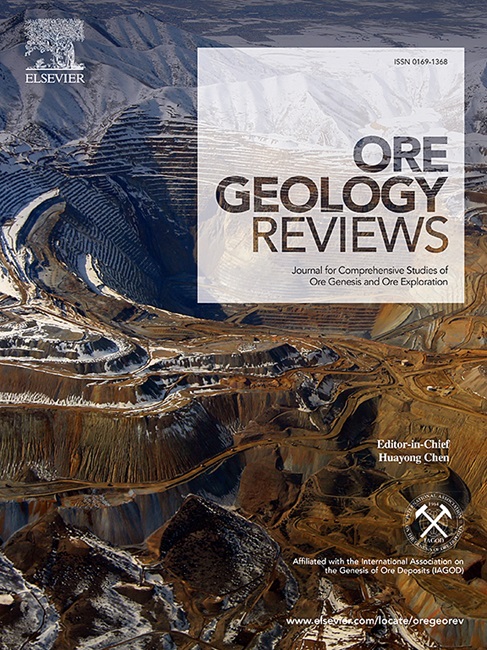中国珠光山花岗岩相关铀矿区的流体覆盖和成矿作用:石英的阴极发光纹理和化学成分记录
IF 3.2
2区 地球科学
Q1 GEOLOGY
引用次数: 0
摘要
大多数高品位铀矿都是从花岗岩中的石英矿脉中开采出来的。这些矿脉是在偶发性热液活动中在浅层形成的,但多阶段流体的演化还没有得到很好的解释。在这项研究中,我们从中国南方与花岗岩有关的世界级珠光山铀矿区(来自七个矿床的 17,000 吨铀)采集了 56 个石英样品。我们使用扫描电子显微镜阴极发光法(SEM-CL,n = 98)和激光烧蚀-感应耦合等离子体质谱法(LA-ICP-MS,n = 643)对这些样品的纹理和成分进行了分析。确定了四种类型的石英,包括岩浆石英、早期热液蚀变石英、矿石期热液石英(富含铀)和晚期热液石英。新的石英纹理和化学成分表明,早期热液石英从岩浆阶段向热液阶段的过渡是不连续的,这与在大多数岩浆-热液系统中观察到的连续趋势不同。矿石阶段的石英呈 CL 暗色(峰值为 650 纳米),在早期贫瘠石英上形成边缘,锰、铝和锑含量较高。岩浆石英的蚀变纹理是通过低温下的流体-岩石反应形成的,而热液石英的边缘纹理则是在随后的晚期含铀流体事件中形成的,在铀矿化过程中起着至关重要的作用。与其他岩浆-热液系统相比,珠光山铀矿区的石英具有明显的特征,可以为该系统以及其他与花岗岩有关的铀矿系统的高品位矿石勘探提供指导。本文章由计算机程序翻译,如有差异,请以英文原文为准。

Fluid overprints and mineralization of the Zhuguangshan granite-related U district in China: Recorded by cathodoluminescence textures and chemistry of quartz
Most high-grade U ores are mined from quartz veins hosted in granites. The veins formed at shallow depths during episodic hydrothermal activity, however, the evolution of multiple stage fluids is not well constrained. In this study, we collected 56 quartz samples from the world-class, granite-related, Zhuguangshan U district (>17,000 t U from seven deposits) in southern China. Their textures and compositions were analyzed using scanning electron microscope cathodoluminescence (SEM-CL, n = 98) and laser ablation-induction coupled plasma-mass spectrometry (LA–ICP–MS, n = 643). Four types of quartz were identified, including magmatic quartz, early hydrothermal euhedral quartz, ore stage hydrothermal quartz (U-rich), and late hydrothermal quartz. New quartz textures and chemical compositions show that the transition of early hydrothermal quartz from the magmatic to hydrothermal stages is discontinuous, unlike the continuous trend observed in most magmatic-hydrothermal systems. Ore stage quartz is CL dark (with a peak at 650 nm), occurs as rims on early barren quartz, and has high contents of Mn, Al, and Sb. Altered textures of magmatic quartz developed through fluid-rock reactions at low temperatures, while rimmed textures of hydrothermal quartz formed during subsequent late-stage U-bearing fluid events, which played a crucial role in U mineralization. Quartz in the Zhuguangshan U district has distinct features compared to other magmatic-hydrothermal systems that can guide exploration for high-grade ore in this, and perhaps other, granite-related U systems.
求助全文
通过发布文献求助,成功后即可免费获取论文全文。
去求助
来源期刊

Ore Geology Reviews
地学-地质学
CiteScore
6.50
自引率
27.30%
发文量
546
审稿时长
22.9 weeks
期刊介绍:
Ore Geology Reviews aims to familiarize all earth scientists with recent advances in a number of interconnected disciplines related to the study of, and search for, ore deposits. The reviews range from brief to longer contributions, but the journal preferentially publishes manuscripts that fill the niche between the commonly shorter journal articles and the comprehensive book coverages, and thus has a special appeal to many authors and readers.
 求助内容:
求助内容: 应助结果提醒方式:
应助结果提醒方式:


